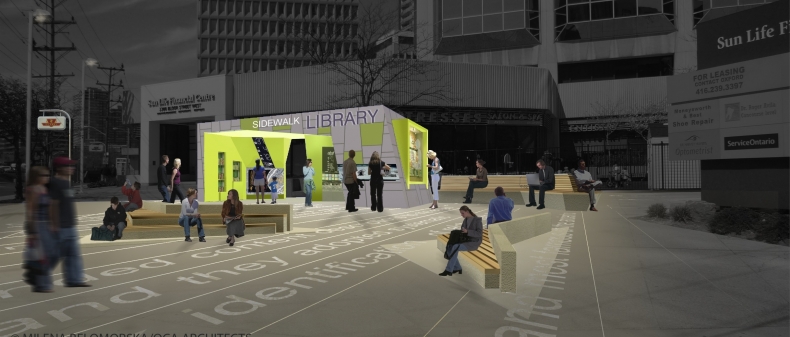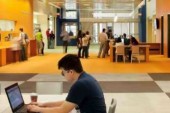
Sidewalk Library by Milena Belomorska, OCA Architects Inc. Courtesy of Ontario Association of Architects, Future of Architecture exhibit
Charting a course to 2050 is going to be a daunting task for any city. Over the next few weeks, Justin Robertson will be placing a microscope on Toronto’s key industries and institutions that will be shaped by the predicted population growth facing the city in a series called “The Future of Our City.” The five-part series will examine how the city will be impacted by the aging population, the future of cars and transit and solutions to traffic congestion, and how the face of education and learning environments will change.
This week: We look at the changing face of education and the changes we can expect in classrooms and libraries.
As we gently drift toward 2050, we’ll see a shift in how we think of learning spaces. Take the secondary school classroom as an example: Today, students enter the classroom through one door. There are slabs of tables and chairs aligned uniformly and some rooms are lucky to have more than a handful of windows. It’s stuffy and light levels are not the best. In the corner sits a projector on wheels and the blackboard has seen better days. But that’s going to change. In the future, we shall see more doors, perhaps a series of entry points to rooms that are all linked together. Who remembers the 1986 classic Back To School, when Rodney Dangerfield knocked out the walls of three dorm rooms and had it transformed into this multi-layered frat palace. The space came equipped with velvet couches, a long bar and a massage therapy room. Granted, the future of Toronto’s classrooms will not adopt the philosophies of one Thornton Melon, but his idea of how to use space is a direction classrooms will be shifting toward. The notion of what is a traditional learning space is about to undergo colossal changes. We will say goodbye to clustered work environments and welcome larger flexible spaces that adapt to multiple conditions and projects: guest speakers, exhibits, labs and digital projection. They shall become more conducive to the surrounding environment. For the classroom, think furniture with wheels so space can easily be shaped for group work. Think larger windows and ceilings and more light.
Susan Lewin from CS&P Architects Inc. was part of the recent OAA Future of Architecture exhibit and talked about the future of learning spaces. She told Toronto Standard that with a paradigm shift in learning, we will see less of teachers standing out the front talking for eight hours a day. “[The classroom] is going to be more task-driven that will incorporate the use of technology. Sharing knowledge in groups rather than individuals. Exchanging ideas. Active learning tailored for the independent thinker,” she said. “It’s hard to forecast the next 50 years, but yes, we might see a more university-style implemented in secondary school classrooms — less boundaries, not rigid, very flexible with the ability to customize.”
Technology and how it relates to space will play a sizable role in how learning spaces are conceived and planned. Lewin said, classrooms could take the approach of most wireless city coffee shops and how they attract people with laptops who set up the work space like miniature labs, in groups or individually. Classrooms will develop a similar model, fitted with plug-ins for everyone’s learning devices and hardware. “Curriculum will be cross disciplinary and how it relates to physical space,” she said. “It will need to be designed for interaction. Future rooms will focus on green space, air quality, good light, movement and mobility. It will create a new school experience. Classrooms will be wired for technology.”
And while classrooms are expected to evolve, so too are libraries. The digital age has changed the way we view the role of a library. It used to be a space where you’d travel to, for a specific book or subject and spend hours researching and reading public material. It used to be the exclusive provider of knowledge. But new media has altered that. The masses now have portable information devices that they use and carry in their pockets. It’s changed the way we communicate and interact as a society and now we have become so dependent on it, that we crave connectivity. Earlier this year Mayor Rob Ford tried to cut hours at 98 of the city’s library branches in an effort to cut public spending, but Milena Belomorska from OCA Architects Inc. said we need to find a way to fit them into our evolving technology. “The values the library stands for have not diminished and the recent out pour of public support against the closing down of branches and cutting services shows that,” she said. “But the key to its survival will be in its ability to innovate and adapt its programs and facilities so that they remain relevant and useful part of our daily digital lives.”
Belomorska has dedicated the last three years to researching and outlining a comprehensive innovation plan for the Toronto Public Library System through a report titled Library City: The Future of the Public Library in the Digital Age. A small portion of it was presented at the recent OAA Future of Architecture exhibit. One method to fit libraries into Toronto’s urban landscape is to disperse branches into smaller outlets, or “sidewalk libraries,” so that it can offer services to its users at the point of need. A sidewalk library would consist of a lightweight structure, but also easily deployed in all corners of the city. They’ll become rapid-fire information spaces and will have access to library material but also to personal data stored in the library cloud. We will see them scattered along commuter corridors and at places of intensified public use in order to bring the library closer to the street and to pedestrian routes.
Belomorska said libraries will offer both books and digital materials and provide spaces that cater to mobile users as well as regular patrons. “Each outlet could be designed, decorated, and programmed to reflect the specific neighbourhood character and history. The intent is that at each outlet, users can download library material and also upload their own, or, if they wish, enter their own book collection into the library system through the ‘open shelf’ program,” she said. “Based on the assumption that cloud-based services will be the centre of digital life, sidewalk libraries are expected to become essential fixtures in the urban geography of information — outlets on which more and more people will rely for their daily affairs.”
In an internet-driven society, where up-to-the-minute communication dominates our lives, technology will play a pivotal role in changing how our learning spaces will evolve from now until 2050. Not only do we have to adapt, but we need to mould it and seek ways to absorb it into our urban fabric. Classrooms should become learning centers and students should have information easily accessible like bustling digital hub. They need to incorporate digital projectors and help spark creative learning. Libraries have a place outside the realm of a three-story building. Conversations by city experts and architects have established that the best way forward to create a livable city of the future is by building mid-rise communities that accommodates transit and easy-to-get groceries — libraries can also fit into this urban picture. Belomorska said we need to think of libraries as part of city infrastructure like transit and or power rather than electricity and traffic. “Perhaps we need to think not in terms of ‘city libraries’ but of ‘Library City.'”
Next week: Part IV The future of food production, distribution and preparation.
____
Justin Robertson is a freelance journalist from Toronto. His work has appeared in The Walrus, National Post and Toronto Standard. Follow Justin on Twitter @justinjourno
For more, follow us on Twitter @TorontoStandard and subscribe to our newsletter.














